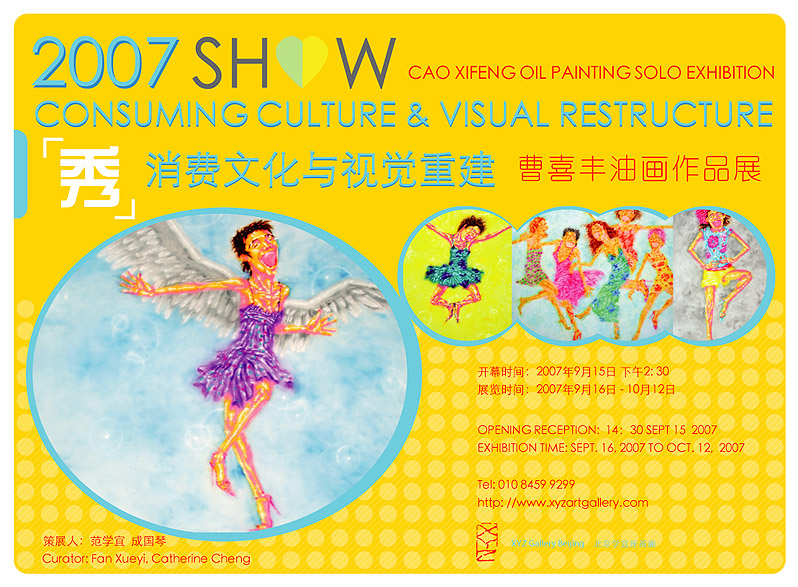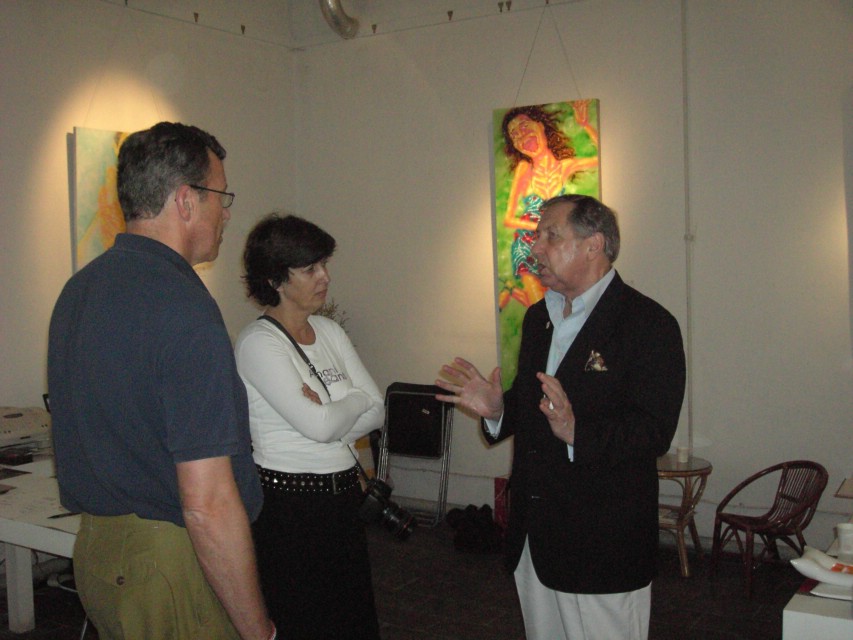|
2007 < SHOW > CONSUMING CULTURE & VISUAL RESTRUCTURE CAO XIFENG OIL PAINTING SOLO EXHIBITION

Opening Reception: Sept. 15, 2007, 14;30PM
Exhibition Time: 1100-1900 from Sept. 16 to Oct. 12, 2007
Venue: XYZ Gallery, D06-6-1 of 798 Dashanzi Art Center
Curator: Fan Xueyi & Catherine Cheng
BIOGRAPHY OF CAO XIFENG
1977 born in Zhucheng of Shangdong Province
2004 graduated from Oil Painting Faculty of Guangzhou Fine Arts Academy
2005 Emotional City Oil Painting Exhibition
3+3 Art Space, Beijing
2006 2006 Cao Xifeng SHOW Solo Exhibition, XYZ Gallery, 798 Dashanzi Art Center
2007 Shanghai International Spring Art Salon Exposition

ARTIST STATEMENT
The theme of Consuming Culture & Visual Restructure originates from an article I wrote several years ago, which might disclose the various main concepts of contemporary Chinese culture, as well as my self contemplation and academic background of my artistic creation.
In general, consuming culture is mass culture, while the consumerism is the major characteristic of mass culture. As being the mainstream of cultural form, mass culture appears gradually in accordance with the in-depth social reform in contemporary China. As the self-supplied naturally-formed economy with the agricultural-based civilization started to step down, open reform* enables the product economy to be established, which the product economy bases on the industrial civilization, orients on market. As a result, people’s mentality varies accordingly. The social feature in the course of China’s transition occurs particularly at such phenomenon as worship of material, destruction of mainstream belief**, emancipation of ideology, individual awakening, dramatic flow in population, emergence of new class, family-centered legislation*** deteriorating, social restructure and integration. Consequently, it has the enormous impact on culture, thus the “elite culture****”, as the position of mainstream, begins to fade. The high level academic theory, as well as the profound philosophical thesis, all hides away. Those ancient Chinese philosophers’ thoughts and books are oblivious, which used to be regarded as the essence for the nation and people to survive and develop. Instead, the culture of internet, movie and video, popular novel and music, becomes the majority of mass consuming culture.
As for three aspects that consuming culture delivers in contemporary, it is, first of all, its “anti-culture” tendency. It results in the dissipation of dictatorship in terms of speech by “elite culture”. Culture, in other hands, neither is up to heaven with its pursuit of divinity and power, possessing the culture, to some extent, nor equally possesses a spiritual salvation or a power. Rather, it is the daily consumption for the mass.
Secondly, consuming culture highlights entertaining spirit. Relaxation, easy digestion, stimulation, as well as having fun turn out to be the obvious characteristic. Avoiding heaviness, pursuing lightness, more are focused on satisfaction of sensational instinct, while the spiritual and poetic pursuit ignored. The motif of my painting works concerns about the situation of both survival and spirit in contemporary, which describes as that life could not be burdened by such lightness.
Thirdly, consuming culture emphasizes the individuality. Multi-cultural needs break the ice of human’s differentiation in terms of ideology and knowledge. With Self awakening, as well as pursuit of freedom, more expression on the basis of humanity, enables the artistic creation and style to appear in multiple cultural tendency.
When culture becomes consuming product, the contemporary language, as well as the cultural tendency, causes the concept of aesthetics to be illustrated in diversity. In tradition, the meaning of aesthetics is to transcend the emotional desire for material. Thus, the ancient classical aesthetic principal encounters rebellion upside down, which the supreme law was to pursue nobleness, truth, beauty and benevolence, with its original form of tragedy. Under the influence of consuming culture, various artistic forms have been established, such as pop art, criminal art, carton animation, erotic art, non-title art, dark sarcasm, illusive realism etc., as to new features of aesthetics. The meaning of Visual Restructure is to call for the aesthetics to be rewritten or incessantly written when the newly emerged cultural art could not be explained enough by the traditional aesthetics.
By Cao Xifeng
July 2007
Translated by Catherine Cheng
|

